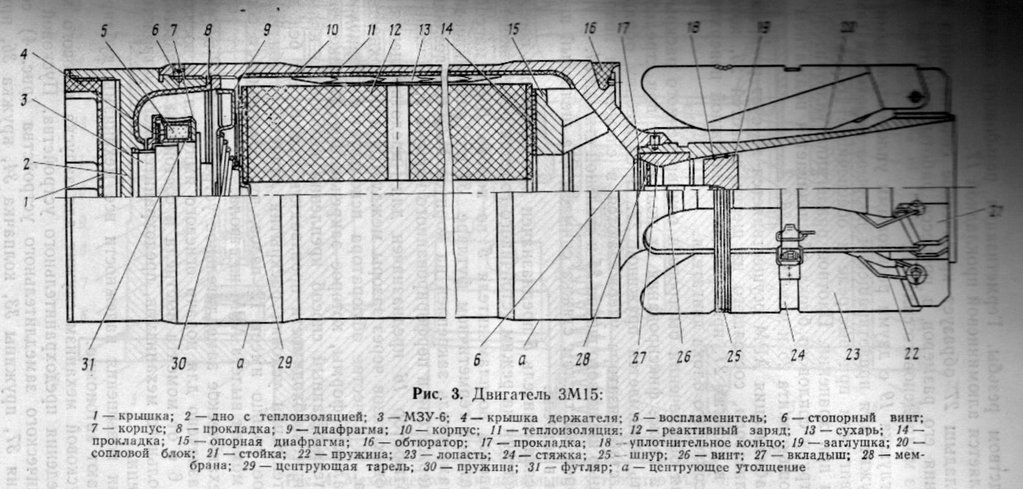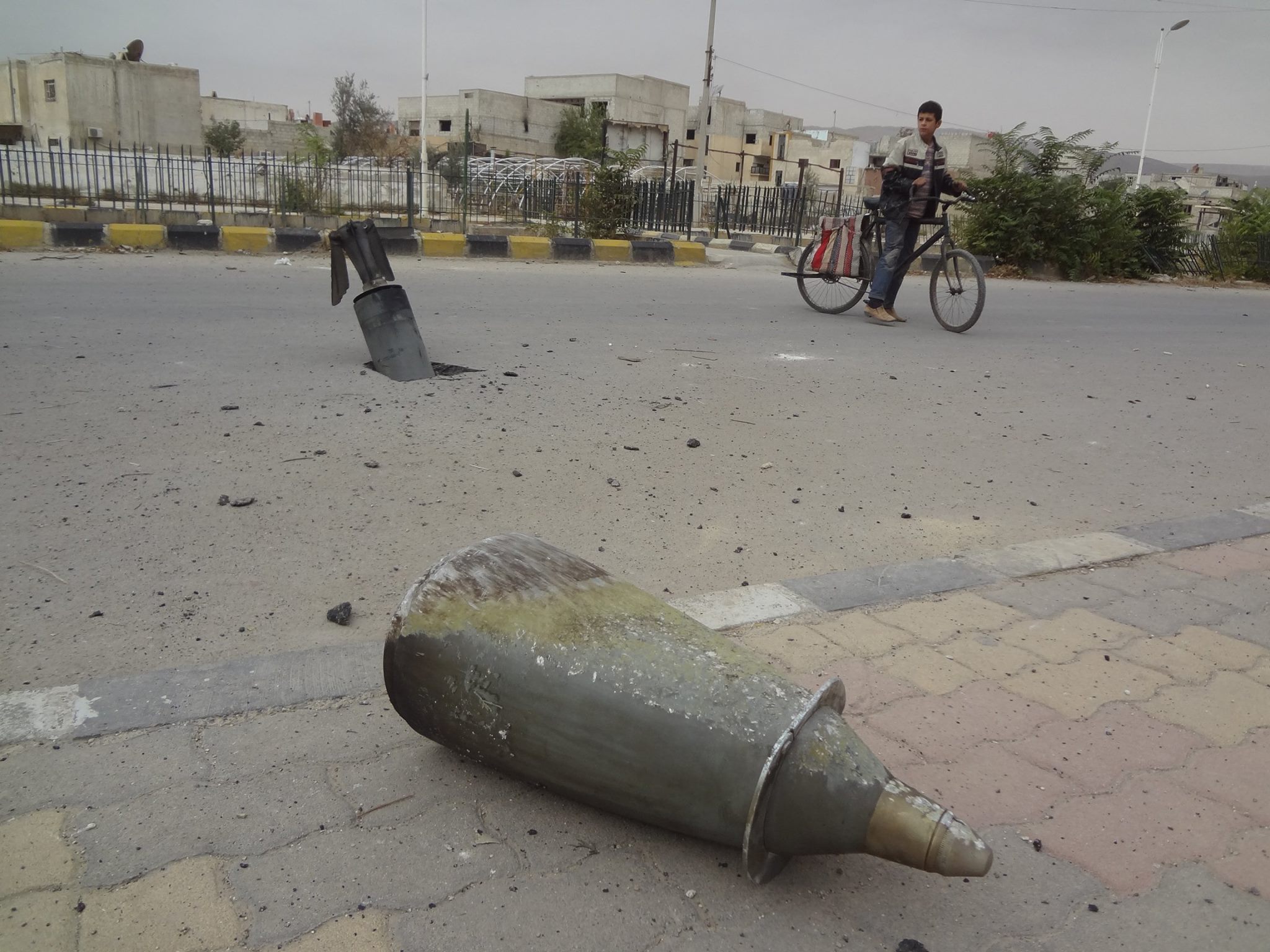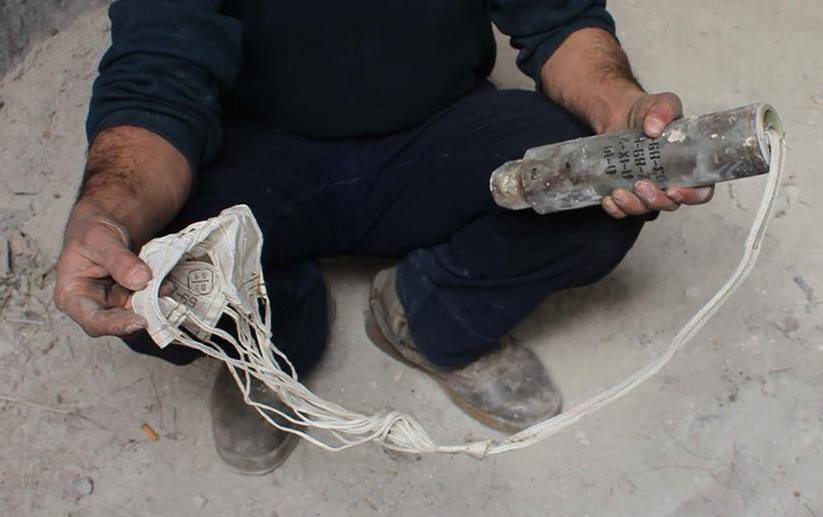Yuri Lyamin and N.R. Jenzen-Jones
Update 31 Jan 16: Further examples of O-10 submunitions have been documented in Douma, Syria on 27 January 2016 (see images below). These submunitions bear markings indicating that they were also manufactured in 1989. Additionally, in mid-January further images were posted to social media showing remnants from 3O8 cargo projectiles. Whilst several examples of these have now been sighted, (one pictured below) is significant in showing a remnant which displays the markings “3-O-9”. It is believed this designation refers specifically to the cargo warhead of the munition, whilst the 3O8 designation refers to the entire munition, including rocket motor and loaded submunitions.
Images posted to social media and activist websites from late October through to mid-December 2015 show the remnants of 240 mm heavy mortar projectiles which have struck various suburbs of Damascus, Syria. Specifically, these remnants are identifiable as components of rocket-assisted mortar projectiles, heretofore unseen in Syria. Previously, only 53-F-864 high explosive (HE) projectiles had been documented in Syria. The photo above shows remnants from a 240 mm rocket-assisted mortar projectile, specifically a 3M15 rocket motor with its distinctive arrangement of six stabiliser fins.
From the late 1960s through the 1980s, four rocket-assisted 240 mm mortar projectiles were designed in the Soviet Union for use with the self-propelled 2S4 Tyulpan and towed M-240 mortar systems. These developments effectively double the range of standard F-864 HE rounds, from 9.65 km to some 18 to 19.6 km, varying by type. The rocket-assisted projectiles are designated the 3F2 Gagara (HE), 3O8 Nerpa (cargo), 3B11 (nuclear), and Sayda (incendiary). All of these use the 3M15 rocket motor.
The 3M15 rocket motor remnants were accompanied by two types of unexploded submunitions, as seen in this YouTube video. The smaller submunition, on the ground at centre in the image below, is an AO-1SCh high explosive fragmentation (HE-FRAG) submunition – a type documented in Syria with some regularity by ARES. The submunition being held by the figure in the image is an O-10 HE-FRAG submunition, which are delivered by the 3O8 cargo (‘cluster’) projectile. These submunitions are not thought to have been previously documented in any conflict zone, despite persistent rumours of use in Chechnya. For example, the image below is claimed to have been taken in 2000 by a Russian 2S4 Tyulpan self-propelled artillery vehicle commander, showing the loading of what’s purported to be a 3O8 cargo projectile with O-10 submunitions.
The 3O8 cargo projectile contains 14 O-10 submunitions. Relatively little is known about these, although they are believed to contain 640 g of A-IX-2, an explosive composition consisting of 73% RDX, 23% aluminium powder, and 4% wax as a phlegmatiser. The submunitions are fitted with one of four PS-69 series parachute systems, employed with various Soviet and Russian munitions. ARES has documented remnants of PS-12127-69 parachutes, for example, in East Ghouta in August this year, and elsewhere in Damascus late last month.

Given the presence of O-10 submunitions, at least some of the remnants documented in Damascus are from the 3O8 rocket-assisted cargo munition. When fitted with a V-120E fuze, 4BN56 propellant charge, and 3Ch20 braking device (if desired) the complete round is designated the 3VO11. The distinctive 3Ch20 braking device (‘brake ring’) used with 240 mm rocket-assisted projectiles is visible in another image from Damascus, below, posted to Facebook on 5 November 2015. The 3Ch20 is used to reduce the overall range of the projectile.
The 3O8 projectile was designed in the Soviet Union in the late 1970s, and introduced into Soviet military service in 1983. Markings indicate that, in at least one instance, both the rocket motor and the submunitions were produced in 1989. It is of course possible that other 240 mm rocket-assisted mortar projectiles have been employed, in addition to the 3O8.
Technical Specifications (3O8 rocket-assisted mortar projectile)
Overall weight: 230 kg
Warhead weight: 112 kg
Propellant charge weight: 3.7 kg
Rocket motor charge weight: 42 kg
Range: 7.1 to 19.3 km (maximum range reduced to 15 km with brake rings)
Number of submunitions: 14
Submunition weight (ea): 3.9 kg
Submunition explosive weight (ea): 640 g
 A technical diagram of the 3M15 rocket motor, taken from an original Russian-language manual.
A technical diagram of the 3M15 rocket motor, taken from an original Russian-language manual.
 A display example of a 3O8 cargo projectile, showing loaded O-10 submunitions.
A display example of a 3O8 cargo projectile, showing loaded O-10 submunitions.
 Remnants from a 240 mm rocket-assisted mortar projectile in Damascus.
Remnants from a 240 mm rocket-assisted mortar projectile in Damascus.
Syria was one of the few states which received 240 mm heavy mortar systems from the Soviet Union, and has continued to employ them in service. During the Syrian Civil War, M240 towed mortars were used during the battle for Homs in 2012. Evidence of 240 mm mortar projectiles has been very scarce since that time. It may be that the Syrian Arab Army (SAA) had expended a significant portion of its stockpile of F-864 HE projectiles during these 2012 engagements. Some sources have suggested that the renewed use of 240 mm systems is related to increasing Russian support for the Syrian government, however this remains unconfirmed. Regardless, it appears that these munitions were most likely employed by SAA forces.
ARES has so far documented remnants of more than two dozen 240 mm rocket-assisted projectiles in Damascus in 2015. If you have further data on their use, either within Damascus or elsewhere, please contact us.
Special thanks to Yasser Aldoumani, Kenton Fulmer, Eliot Higgins, Mark Hiznay, Ilya A., and a confidential source.
Remember, all arms and munitions are dangerous. Treat all firearms as if they are loaded, and all munitions as if they are live, until you have personally confirmed otherwise. If you do not have specialist knowledge, never assume that arms or munitions are safe to handle until they have been inspected by a subject matter specialist. You should not approach, handle, move, operate, or modify arms and munitions unless explicitly trained to do so. If you encounter any unexploded ordnance (UXO) or explosive remnants of war (ERW), always remember the ‘ARMS’ acronym:
AVOID the area
RECORD all relevant information
MARK the area to warn others
SEEK assistance from the relevant authorities





